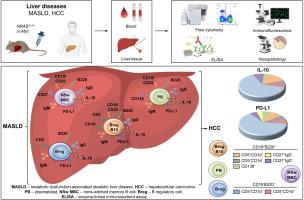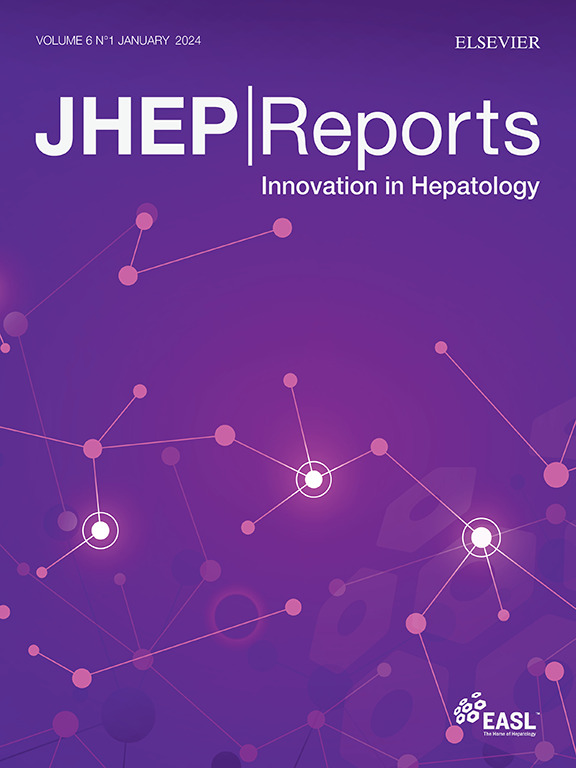Essential roles of B cell subsets in the progression of MASLD and HCC
IF 9.5
1区 医学
Q1 GASTROENTEROLOGY & HEPATOLOGY
引用次数: 0
Abstract
Background & Aims
Hepatocellular carcinoma (HCC) is the third leading cause of cancer-related death. Metabolic dysfunction-associated steatotic liver disease (MASLD) is a significant cause of HCC. Current treatment options for HCC are very limited. Recent evidence highlights B cells as key drivers in MASLD progression toward HCC. However, it remains unclear whether multiple B cell populations or a distinct B cell subset regulates inflammatory responses during liver disease progression. The scope of this study was to define protumorigenic B cell subsets in MASLD and HCC.
Methods
Multicolor flow cytometry, immunohistochemistry, and immunofluorescence analyses were performed to investigate B cell populations locally (in liver tissue) and systemically (in the blood) in mice with MASLD (n = 6) and HCC (n = 5–6). The results obtained in mice were also verified in patients with MASLD (n = 19) and HCC (n = 16).
Results
Our study revealed an increase of two regulatory B cell (Breg) subsets, CD19+B220+CD5+CD1d+ (p <0.0001) and CD19-B220+CD5+CD1d- (p <0.0001), both of which highly overexpress IgM/IgD, PD-L1, and IL-10, in the livers of mice with MASLD and HCC. Furthermore, we showed that B-cell depletion therapy in combination with a Listeria-based vaccine decreased CD19-B220+CD5+CD1d- Bregs (p = 0.0103), and improved survival of mice with HCC. We also found CD19+CD5+IL-10+ (p = 0.0167), CD19+CD5+PD-L1+ (p = 0.0333) and CD19+CD5+IgM+IgD+ (p = 0.0317) B cells in human HCCs. In addition, strong overexpression of IgM/IgD, PD-L1, IL-10, were detected on non-switched memory B cells (p = 0.0049) and plasmablasts (p = 0.0020). The examination of blood samples obtained from patients with MASLD showed an increase of total B cells expressing IL-10 (p <0.0001) and IgM/IgD (p = 0.3361), CD19+CD20+CD5+CD1d+ Bregs (p = 0.6424) and CD19+CD20+CD27+ non-switched memory B cells (p = 0.0003).
Conclusions
Our results provide novel insights into the protumorigenic roles of several B cell subsets, the specific targeting of which could abrogate the progression of liver disease.
Impact and implications
Hepatocellular carcinoma (HCC) is the primary liver cancer with a constantly rising mortality rate. Metabolic dysfunction-associated steatotic liver disease (MASLD) is an emerging important cause of HCC. Current treatment options for HCC are limited and there is a high risk of recurrence. The study aims to identify new therapeutic strategies by exploring the immunological aspects of MASLD and HCC. Our findings extend the current knowledge on the role of B cells in the progression of MASLD and HCC. This study emphasizes the involvement of IgM+IgD+ regulatory B cells (Bregs) in malignant liver disease progression. These Bregs characterized by a high expression of PD-L1, IL-10, IgM, and IgD. Two other B cell subsets with immunosuppressive phenotype have been found in the study in murine liver disease - plasmablasts and non-switched memory B cells. Targeting these B cells could lead to more effective treatments of HCC.

B 细胞亚群在 MASLD 和 HCC 进展过程中的重要作用
背景& 目的肝细胞癌(HCC)是癌症相关死亡的第三大原因。代谢功能障碍相关性脂肪性肝病(MASLD)是导致 HCC 的重要原因。目前治疗 HCC 的方法非常有限。最近的证据表明,B 细胞是 MASLD 向 HCC 发展的关键驱动因素。然而,在肝病进展过程中,是否有多个 B 细胞群或一个独特的 B 细胞亚群调节炎症反应,目前仍不清楚。本研究的目的是确定 MASLD 和 HCC 中的原发肿瘤性 B 细胞亚群。方法采用多色流式细胞术、免疫组织化学和免疫荧光分析方法,研究 MASLD 小鼠(n = 6)和 HCC 小鼠(n = 5-6)局部(肝组织)和全身(血液)的 B 细胞群。结果我们的研究发现,在患有 MASLD 和 HCC 的小鼠肝脏中,CD19+B220+CD5+CD1d+ (p <0.0001)和 CD19-B220+CD5+CD1d- (p <0.0001)这两种调节性 B 细胞 (Breg) 亚群有所增加,它们都高度过表达 IgM/IgD、PD-L1 和 IL-10。此外,我们还发现,结合李斯特菌疫苗的 B 细胞耗竭疗法可减少 CD19-B220+CD5+CD1d- Bregs(p = 0.0103),并提高 HCC 小鼠的存活率。我们还在人类 HCC 中发现了 CD19+CD5+IL-10+ (p = 0.0167)、CD19+CD5+PD-L1+ (p = 0.0333) 和 CD19+CD5+IgM+IgD+ (p = 0.0317) B 细胞。此外,在非转换记忆 B 细胞(p = 0.0049)和浆细胞(p = 0.0020)中检测到 IgM/IgD、PD-L1、IL-10 的强过量表达。对 MASLD 患者血液样本的检查显示,表达 IL-10 (p <0.0001)和 IgM/IgD (p = 0.3361)、CD19+CD20+CD5+CD1d+ Bregs (p = 0.6424) 和 CD19+CD20+CD27+ 非转换记忆 B 细胞 (p = 0.0003) 的 B 细胞总数增加。影响和意义肝细胞癌(HCC)是死亡率持续上升的原发性肝癌。代谢功能障碍相关性脂肪性肝病(MASLD)是新出现的导致 HCC 的重要原因。目前治疗 HCC 的方法有限,而且复发风险很高。本研究旨在通过探索 MASLD 和 HCC 的免疫学方面来确定新的治疗策略。我们的研究结果扩展了目前关于 B 细胞在 MASLD 和 HCC 进展中的作用的知识。这项研究强调了IgM+IgD+调节性B细胞(Bregs)在恶性肝病进展中的参与。这些 Bregs 的特征是高表达 PD-L1、IL-10、IgM 和 IgD。在对小鼠肝病的研究中还发现了另外两种具有免疫抑制表型的 B 细胞亚群--浆细胞和非转换记忆 B 细胞。以这些B细胞为靶点,可以更有效地治疗HCC。
本文章由计算机程序翻译,如有差异,请以英文原文为准。
求助全文
约1分钟内获得全文
求助全文
来源期刊

JHEP Reports
GASTROENTEROLOGY & HEPATOLOGY-
CiteScore
12.40
自引率
2.40%
发文量
161
审稿时长
36 days
期刊介绍:
JHEP Reports is an open access journal that is affiliated with the European Association for the Study of the Liver (EASL). It serves as a companion journal to the highly respected Journal of Hepatology.
The primary objective of JHEP Reports is to publish original papers and reviews that contribute to the advancement of knowledge in the field of liver diseases. The journal covers a wide range of topics, including basic, translational, and clinical research. It also focuses on global issues in hepatology, with particular emphasis on areas such as clinical trials, novel diagnostics, precision medicine and therapeutics, cancer research, cellular and molecular studies, artificial intelligence, microbiome research, epidemiology, and cutting-edge technologies.
In summary, JHEP Reports is dedicated to promoting scientific discoveries and innovations in liver diseases through the publication of high-quality research papers and reviews covering various aspects of hepatology.
 求助内容:
求助内容: 应助结果提醒方式:
应助结果提醒方式:


